| کد مقاله | کد نشریه | سال انتشار | مقاله انگلیسی | نسخه تمام متن |
|---|---|---|---|---|
| 607972 | 880565 | 2012 | 8 صفحه PDF | دانلود رایگان |

Nanoemulsions can be used for the encapsulation and oral delivery of bioactive lipophilic components, such as nutraceuticals and pharmaceuticals. There is growing interest in the utilization of low-energy methods to produce edible nanoemulsions. In this study, we examined the influence of system composition and preparation conditions on the formation of edible nanoemulsions by the emulsion phase inversion (EPI) method. The EPI method involves titrating an aqueous phase (water) into an organic phase (oil + hydrophilic surfactant). The influence of oil type, surfactant type, surfactant-to-oil ratio (SOR), and initial surfactant location on the particle size distributions of the emulsions was studied. The droplet size produced by this method depended on: (i) oil type: medium chain triglycerides (MCT) < flavor oils (orange and limonene) < long chain triglycerides (olive, grape, sesame, peanut and canola oils); (ii) surfactant type: Tween 80 < Tween 20 < Tween 85; (iii) surfactant concentration: smaller droplets were produced at higher SOR; (iv) surfactant location: surfactant initially in oil < surfactant initially in water. The low energy method (EPI) was also compared to a high energy method (microfluidization). Small droplets (d < 160 nm) could be produced by both methods, but much less surfactant was needed for the high energy method (SOR ⩾ 0.1) than the low energy method (SOR ⩾ 0.7).
Figure optionsDownload high-quality image (74 K)Download as PowerPoint slideHighlights
► A low energy method of producing food-grade emulsions was examined.
► The influence of oil type, surfactant type, and system composition was studied.
► Small droplets could be produced for certain oils and surfactants.
► A high surfactant-to-oil ratio was needed to produce small droplets.
Journal: Journal of Colloid and Interface Science - Volume 388, Issue 1, 15 December 2012, Pages 95–102